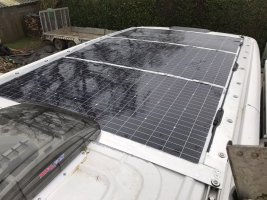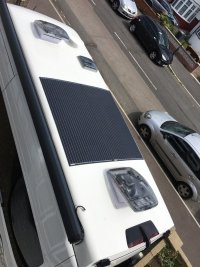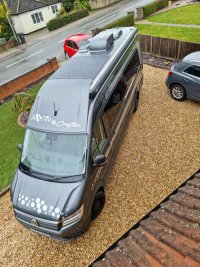With the vast array of panels on the market, I was having a dilemma as to type of panels.
Having opted for 3x160 Watt flexible panels , the size between the gutters was absolutely perfect. In order to keep the assembly to a lower profile as opposed to on a ridged frame . And somewhat more streamlined.
This gave upto 480 watts.
Using stainless Unistrut this allows you to secure the panels around the edges with thin plate, then using Sikaflex to adhere the panels onto the roof, still allowing air to flow and any rain water to escape.
The Unistrut comes in 3 or 6 metre lengths, and allows you to run the solar wires within the channels.
If you decide to have an awning, there are various options for fixing the support brackets to the spring loaded nuts which fit in the strut. Fixing the Unistruts to the gutter was also straightforward as being peppered with elongated holes there was a suitable hole in the van roof gutter that married up. Sealing the bolt holes is crucial.
In hind sight, I think I’d put s/steel thin sheet adhered to each solar panel, just to make them a little more sturdy, yet flex, then stick to roof ribs, as some deflection has taken place since, however the panels continue to push out the original wattage to date.

Having opted for 3x160 Watt flexible panels , the size between the gutters was absolutely perfect. In order to keep the assembly to a lower profile as opposed to on a ridged frame . And somewhat more streamlined.
This gave upto 480 watts.
Using stainless Unistrut this allows you to secure the panels around the edges with thin plate, then using Sikaflex to adhere the panels onto the roof, still allowing air to flow and any rain water to escape.
The Unistrut comes in 3 or 6 metre lengths, and allows you to run the solar wires within the channels.
If you decide to have an awning, there are various options for fixing the support brackets to the spring loaded nuts which fit in the strut. Fixing the Unistruts to the gutter was also straightforward as being peppered with elongated holes there was a suitable hole in the van roof gutter that married up. Sealing the bolt holes is crucial.
In hind sight, I think I’d put s/steel thin sheet adhered to each solar panel, just to make them a little more sturdy, yet flex, then stick to roof ribs, as some deflection has taken place since, however the panels continue to push out the original wattage to date.



